PRINCETON, NJ -- New USA Today/���۴�ýpolling looks at the state of the presidential race in New York, some 10 days before this state votes as part of the crucial Super Tuesday set of primaries.
Republican Race
A USA Today/���۴�ýpoll of New York Republicans finds that as of Wednesday through Saturday of this past week, Arizona Sen. John McCain has a substantial lead over former New York City Mayor Rudy Giuliani. Mitt Romney, who is gaining in Gallup's national polling, is nevertheless in third place in New York. McCain leads both among all registered Republicans who say they will vote, and among a more restricted group of those deemed most likely to vote in a lower-turnout election.
The New York Republican primary appears to be particularly fluid at this point, with almost half of Republican voters saying they might change their minds. That fact, along with the uncertain impact of the results of next Tuesday's important Republican primary in Florida, suggests that there could be significant change between now and the Feb. 5 election.
Vote Intentions as of Jan. 23-26
The four-day USA Today/���۴�ýpoll was conducted Wednesday through Saturday. The results of the basic question asking voters for whom they intend to vote are presented in two ways in the adjacent table. The "high turnout" figures represent the responses of all registered Republicans who said they planned to vote. The "low turnout" figures are those deemed most likely to vote, based on responses to a set of turnout questions.
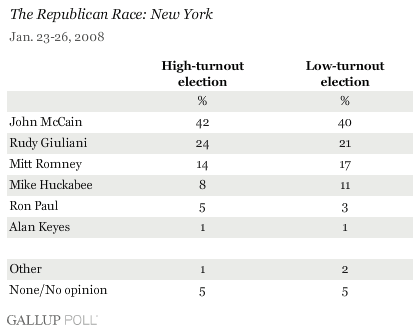
McCain leads Giuliani by 18- and 19-point margins among the turnout groups. Romney is in third place, but at this point would be more competitive with Giuliani for second place in a low-turnout election. Mike Huckabee and Ron Paul are next, with Huckabee a solid fourth in a low-turnout election.
Almost half of Republican voters indicate that they might change their minds about their vote, a relatively high number. By way of comparison, significantly fewer registered Republican voters in California interviewed in a USA Today/���۴�ýpoll conducted over exactly the same period said they might change their minds about their vote preference
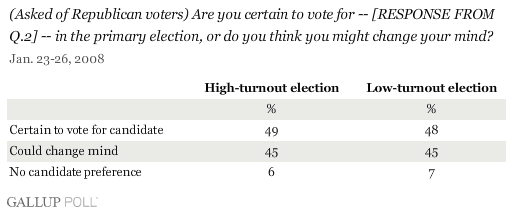
Among those who are certain to vote, McCain maintains his lead, but the large segment of "uncertain" votes suggests that significant changes in these vote preferences would not be unexpected.
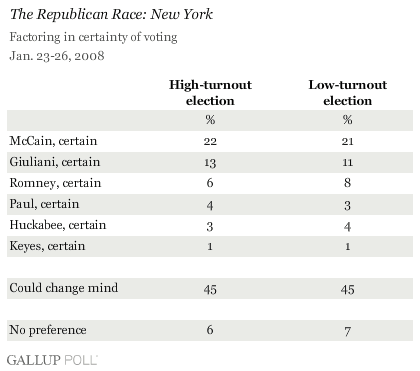
The results of the Florida primary on Jan. 29 would appear to have the highest potential to change the voting intentions of New York Republicans. New Yorker Rudy Giuliani has staked his campaign chances to a large degree on being able to do well in Florida and to ride that momentum into wins on Super Tuesday. At this point, Giuliani is trailing in pre-election polls conducted in Florida, but should he do unexpectedly well there, he could possibly energize support in his native state by next Tuesday. Similarly, a strong win by either McCain or Romney could increase their standing among New York Republicans. Giuliani had been the dominant leader in earlier polls of New York, but as he has faded nationally in recent weeks, he has been overtaken by McCain in his home state.
Democratic Primary
New York's own Sen. Hillary Clinton has a substantial lead over Barack Obama among Democratic primary voters at this point in the race. John Edwards is a distant third.
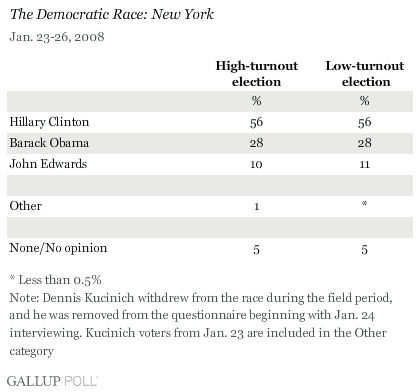
In this particular instance, there is no difference in the voting structure between the group of all registered New York Democrats who plan on voting, and the smaller group of those deemed most likely to vote.
New York Democrats seem significantly more certain in their choices than do New York Republicans. Only about a quarter of New York Democratic voters say they may change their minds about their vote choice.
Among those who are certain about their vote, Clinton's lead remains substantial, with close to half of New York Democratic voters saying they are certain to support Clinton on Feb. 5.
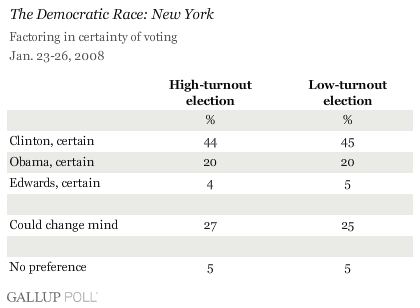
Clinton has led in almost every poll conducted in New York for months, and the current results are certainly no surprise. The surprise would be if Clinton began to falter in her own home state, the one in which she gained an overwhelming margin of victory in her Senate re-election bid in 2006.
Still, this poll was completed before the results of Saturday's South Carolina primary were known. Barack Obama's substantial win in South Carolina, and the publicity that surrounded it, could have an effect on New York Democrats. Additionally, of course, the candidates will be campaigning and advertising in New York in the days leading up to the Feb. 5 vote.
Survey Methods
The Republican results are based on interviews conducted Jan. 23-26, 2008, with 750 New York Republican registered voters who plan to vote in the Republican presidential primary. For this sample, the maximum margin of error attributable to sampling is ±4 percentage points. The Republican results displayed for a "high-turnout election" are based on this broad group of Republican voters.
For results based on the sample of 412 Republican voters in a "low-turnout election," the maximum margin of sampling error is ±5 percentage points. This smaller sample represents Republican primary voters who appear most likely to vote in the primary based on responses to a set of questions about current interest in the election and past voting behavior.
The Democratic results are based on interviews conducted Jan. 23-26, 2008, with 767 New York Democratic registered voters who plan to vote in the Democratic presidential primary. For this sample, the maximum margin of error attributable to sampling is ±4 percentage points. The Democratic results displayed for a "high-turnout" election are based on this broad group of Democratic voters.
For results based on the sample of 426 Democratic voters in a "low-turnout election," the maximum margin of sampling error is ±5 percentage points. This smaller sample represents Democratic primary voters who appear most likely to vote in the primary based on responses to a set of questions about current interest in the election and past voting behavior.
Interviews were conducted with respondents on land-line telephones (for respondents with a land-line telephone in their household) and cellular phones (for respondents who are cell-phone only).
Approximately 2% of the total interviews were conducted in Spanish.
In addition to sampling error, question wording and practical difficulties in conducting surveys can introduce error or bias into the findings of public opinion polls.
